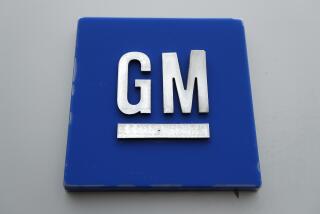New Safety Standards for SUVs Are Expected
- Share via
WASHINGTON — The government’s auto safety chief told a Senate panel Wednesday that his top priority is reducing deaths and injuries in rollovers and in crashes between smaller cars and larger sport-utility vehicles and pickups.
Jeffrey Runge said the National Highway Traffic Safety Administration is considering stronger safety requirements in four areas: tougher door locks that are less prone to popping open, sturdier roofs, side air bags that help keep people from being flung out of vehicles, and new chimes or other systems to remind occupants to buckle up.
Though Runge praised industry efforts to voluntarily tackle SUV safety problems, the Bush appointee said he is prepared to use government mandates to get the job done. “Sometimes a regulation can level the playing field so manufacturers who are willing to invest more in safety are not put in a competitive disadvantage with manufacturers who are not willing to invest more,” he said.
Some new standards, such as the door locks, are expected to be issued later this year. But there is no timetable for a side air bag requirement, the most significant improvement.
Sen. George Allen (R-Va.) decried regulation as a form of government “nannyism,” but other Commerce Committee members indicated they would support higher standards for SUV safety.
Sen. John McCain (R-Ariz.), the panel’s chairman, said he was skeptical of voluntary pledges by automakers. “You have to judge their performance by history,” McCain said. “The auto industry has testified before this committee on numerous [prior] occasions that they couldn’t afford seat belts, couldn’t afford air bags. Where is their credibility in establishing voluntary standards?”
Of the industry’s new pledges to improve SUV safety, McCain said: “I don’t think that’s good enough.”
Safety groups are asking lawmakers to order NHTSA to require side air bags in all vehicles. Now available as an option on many models, side air bags in SUVs would help prevent occupants from being ejected in rollovers, safety advocates say. The bags would also reduce head and neck injuries among people in cars struck by the taller, heavier vehicles, they add.
“A happy benefit can be gained by installing side curtain air bags,” agreed Robert Lange, head of safety for General Motors. But Lange urged lawmakers to allow time for the industry to come up with its own plan. “We believe it is important to move forward,” he said.
Runge said NHTSA is moving ahead with some new mandates. The agency expects to publish a proposal to upgrade door locks later this year and issue new roof-strength requirements in 2004.
He also said the government needs to reexamine fuel-efficiency standards to make sure that they are not contributing to safety problems by increasing weight disparities between the smallest cars and the largest SUVs and pickups.
David Pittle, vice president for technical policy at Consumers Union, called that “unsettling.”
“It’s like telling the kid who complains about the schoolyard bully to wear more padding,” Pittle told the panel. “We need to socialize the highway bully.”
Automakers defend SUVs as safe for their occupants, particularly in head-on, side and rear-impact collisions. However, some SUVs are prone to tip over in sudden maneuvers.
Because people in SUVs are much more likely to die in rollovers, their occupant fatality rate is somewhat higher than the rate for cars. The industry says drivers who don’t wear seat belts are partly to blame for the high death toll in rollovers.
Runge cautioned against concluding that the problem lies chiefly with SUV drivers. He said NHTSA surveys show 79% of SUV occupants buckle up, exceeding the U.S. average of 75% for people in all types of vehicles.
He also stressed that efforts to improve SUV safety also have to address what happens to people in other vehicles that get into crashes with SUVs.
Though light trucks -- SUVs, pickups and minivans -- account for 36% of registered vehicles, they are involved in more than half of fatal two-vehicle crashes with cars, and four of every five people killed in such crashes are in cars.






